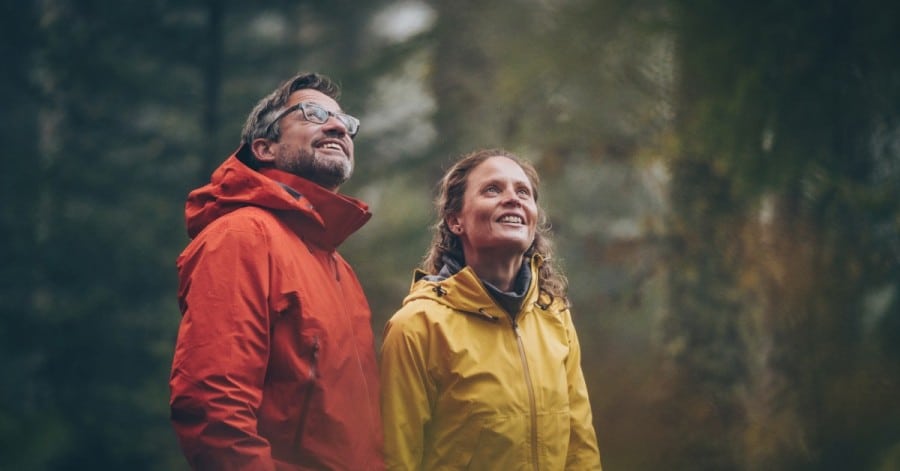Table of Contents
Some links on posts are affiliate links and will earn us a commission from qualifying purchases
If you love hiking in the UK, you’ll know that the weather can be your best friend or your worst enemy – sometimes within the same hour. Choosing the right waterproof jacket isn’t just about grabbing one with “waterproof” on the label. In the British climate, where rain can come out of nowhere, winds can cut right through you, and humidity makes everything feel damp, your jacket is one of the most important bits of kit you’ll buy.
In this guide, we’ll look at what “fully waterproof” really means, break down the jargon (yes, hydrostatic head actually matters!), and explain the key features that make a jacket reliable in the real world.
Why UK Hikers Need a Seriously Good Jacket
The UK doesn’t always get the constant, heavy rain its reputation suggests, but the challenge is in how unpredictable it is. A day that starts dry can turn into a soaking in minutes. Add in wind, hill fog, and humidity, and suddenly you’re wet, cold, and uncomfortable – even in summer.
Here’s why this matters when choosing a jacket:
- Pressure from your kit matters. When rain hits your jacket, that’s one thing. But when you’ve got a backpack pushing down on the shoulders, or you’re moving your arms a lot, you’re putting extra pressure on the fabric. If your jacket’s waterproofing isn’t up to scratch, water will eventually get through.
- Wind chill is no joke. On ridges and higher ground, strong winds can make it feel much colder than the actual temperature. Without good protection, you’re at risk of hypothermia even when it isn’t freezing.
- Humidity makes you sweatier. UK air is often damp. When the air outside is just as humid as inside your jacket, sweat can’t escape easily, leaving you feeling clammy. That’s why jackets with physical vents (like pit zips under the arms) can be lifesavers – they let heat and moisture escape fast.
Understanding Waterproof Ratings and Tech
You’ll see plenty of jargon when you shop for jackets, but here’s what really matters:
1. Hydrostatic Head (HH)
This measures how waterproof the fabric is. Think of it like this: it’s the height of a column of water the fabric can hold back before leaking.
- 1,000–3,000mm: Fine for a drizzle or light showers.
- 10,000mm: Okay for everyday use, but might leak under backpack straps.
- 20,000mm+: What you really want for serious UK hiking. It’s tough enough to keep you dry even in prolonged rain with a heavy pack.
2. Breathability
This tells you how well sweat vapor can escape through the fabric. If a jacket doesn’t breathe, you’ll get just as wet — only from your own sweat!
- Good jackets have either a high MVTR rating (20,000 g/m²/24hr or more) or a low RET score (0–6 is excellent).
- But don’t get too hung up on numbers – there’s no industry standard for testing, so brands can’t always be compared like-for-like.
- Look for design features that help with breathability, like pit zips or mesh-lined pockets. These are more reliable than just trusting a number on a label.
3. Jacket Construction
You’ll see jackets described as 2-layer, 2.5-layer, or 3-layer.
- 3-layer jackets are the gold standard for serious hikers. They’re the most durable, most protective, and built to last years of use.
4. Fabrics & Membranes
Not all waterproof fabrics are equal:
- Gore-Tex has been the benchmark for years, with its microporous membrane that stops rain but lets sweat escape.
- PFAS-free technologies (like Montane’s Petrichor) are becoming more popular, offering eco-friendlier waterproofing.
- Páramo’s Nikwax Analogy is different – it doesn’t rely on a membrane at all but instead “pumps” moisture away from your body. It’s brilliant for UK humidity but feels more like soft clothing than a hard shell.
- Patagonia’s H₂No standard is about durability – they test their jackets to simulate decades of use, which is great if you want gear that lasts.
5. DWR & Seams
Even the best fabric won’t keep you dry if the jacket’s seams leak or the outer fabric gets soaked through.
- DWR (Durable Water Repellent) is a coating that makes rain bead up and roll off. You’ll need to reapply it now and then to keep your jacket working properly.
- Seam taping is crucial – all seams should be fully taped to stop water seeping in.
Key Design Features You Shouldn’t Skip
A jacket can have the best fabric in the world and still perform badly if the design isn’t right. Here’s what to look for:
- Venting: Pit zips are your best friend for preventing that sweaty, “boil-in-the-bag” feeling on climbs.
- Hood: Look for a stiff peak and good adjustability so it stays put in strong wind. If you climb, a helmet-compatible hood is worth it.
- Pockets: High-set pockets are ideal because they stay usable even with a backpack hip belt on. Mesh-lined pockets can also act as extra vents.
Final Thoughts
Choosing the right waterproof jacket is one of the best investments you can make as a hiker. Whether you’re tackling the windswept ridges of the Lake District, exploring the Scottish Highlands, or just heading out for a Sunday walk in the local woods, a good jacket keeps you comfortable, dry, and focused on enjoying the trail – not the weather.
The key is to think about how and where you hike most often. If you spend hours in the hills year-round, a premium shell with top-end breathability and features like pit zips might be worth every penny. If you’re more of a weekend walker, a solid mid-range or value option can deliver excellent protection without breaking the bank.
And don’t forget the bigger picture – many brands are now designing with sustainability in mind, offering PFC-free DWR treatments and recyclable materials. Choosing a jacket that lasts for years and can be repaired or recycled is better for both your wallet and the planet.
Whatever you choose, the most important thing is to get out there and enjoy the walk. A great waterproof jacket isn’t just gear – it’s your ticket to more adventures, rain or shine.
Recent Posts
What Is the Slow Ways Movement and Why It Matters for UK Walkers in 2025
Walking has always been part of everyday life in Britain, but the Slow Ways movement is helping to reshape how people think about getting around on foot. If you enjoy walking for fitness, wellbeing...
Hiking in the UK is more popular than ever in 2025. People are heading outdoors in record numbers, not only to the mountains and national parks but also into their own towns and cities. Rural hiking...


